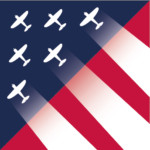Flying Tigers Fought Japanese From China

The American Volunteer Group (AVG), known as “The Flying Tigers”, was a group of American pilots and ground crew who served China in its war against Japan. Their entire combat history covers the seven months from December, 1941 through July, 1942.
The war between China and Japan was the result of the decades-long Japanese goal of establishing an empire in the Pacific. China asked the U.S. for help. The U.S. would not intervene overtly. President Franklin D. Roosevelt approved the purchase of 100 Curtiss P-40B Warhawk fighters by China. The President also authorized reserve officers and enlisted men to resign from the U.S. services and join the AVG in China. They could rejoin their service when their contract time was completed. One hundred pilots and 200 ground crew were recruited.
Retired Army fighter pilot Claire Chennault had been working for the Chinese Air Force. He became the leader of the AVG. Chennault gave the U.S. pilots lessons in the geography and politics of China. He taught them Japanese tactics. He prohibited pilots from engaging in dog fights with the more nimble Japanese fighters. Instead pilots were to conduct diving attacks. The P-40Bs were sturdy, well-armed and faster in a dive. They also had pilot armor and self-sealing fuel tanks. The AVG’s P-40s carried the symbol of China and a shark face on the cowling. The AVG took the name “The Flying Tigers” and adopted Walt Disney’s flying tiger design.
When the U.S. entered the war on December 8, 1941, the AVG had 82 pilots and 79 aircraft. Its first combat mission was on December 20. The AVG supported the Chinese and British fighting against the Japanese offensive into Burma. The group had limited medical support and a shortage of maintenance personnel. Nonetheless, the AVG was credited with 297 enemy aircraft destroyed. Fourteen AVG pilots were killed, captured, or missing in combat. On July 4, 1942, the AVG was disbanded. Chennault rejoined the U.S. Army and commanded all U.S. Army air units in China as a major general. The AVG was replaced by the 23rd Fighter Group of the United States Army Air Forces. Five of the AVG pilots joined the 23rd. Others returned to their services, flew transports in China, or took civilian jobs.
Curator and Historian Gene Pfeffer presents the “Battle of the Bismarck Sea”, the first in a series of history seminars scheduled for the coming year at the National Museum of World War II Aviation.

